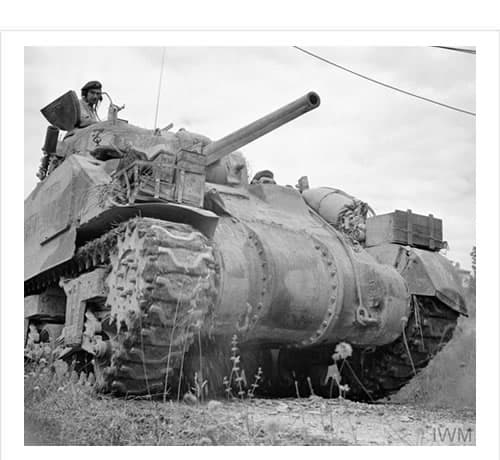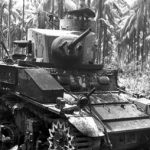June 15
On the evening of June 15, the population heard the first cannon shots, probably fired by the German anti-aircraft positioned in the cemetery area against enemy aircraft.
The Allies, who were proceeding from Rome, were those of the British Eighth Army, XIII Corps, the 78th Division with artillery and reserve units, and the 36th Brigade. They were following two directions: one column came from Monteleone and from Piegaro, another from Fighine-Salci.
The Germans, who had full control of the city from 9 September, positioned themselves in the southwestern part to face the attack. They deployed cannons in the small square of San Pietro and occupied the houses and neighbouring areas.
The population began to run to the shelters.
June 16
On the morning of June 16, the clash was imminent. The Germans concentrated inside the church of San Pietro; they used the bell tower as a lookout point for the valley, occupied the parish priest’s house (Don Pompeo Perai), adjacent to the Baglioni Orphanage and equipped with a small vegetable garden above the Via della Circonvallazione, and finally took possession of other houses where they raided.
Meanwhile, the Allies were advancing and in some places, violent battles were ignited, such as at the Madonna delle Grazie. The bloodiest battle, however, was in the evening and at night in the southern part of Città della Pieve.
The Germans, barricaded in the houses and gardens, tried to stop the advance while the English tried to penetrate the walls.
Many soldiers fell. While the ground operations proceeded, an aerial bombardment was also taking place. The Anglo-Americans pressed to enter the city and the Germans sought every strategy to obstruct them.
For this, they undermined and blew up some buildings along the Casalino, in Via Veneto and along the Vecciano.
At 7 pm, in a shelter organized between the Macchioni house and the Orphanage, a young German showed up who, screaming, asked for the help of four people to treat the wounded who arrived. The two Brenna brothers, Ermanno Mollichella and Gino Uscia introduced themselves.
The parish priest, Don Perai, who was present at the refuge to support his fellow citizens, wanted to go with them. However, he was hit by a barrage of machine guns and died instantly. The body remained unburied for two days until someone mercifully picked it up and took it to the cemetery.
June 17
The fighting continued throughout the day of the 17th and 18th. On the 17th of June, it began to rain; the level of the streams and rivers rose, and the roads became more and more impassable due to the mud. Military operations became even more difficult. The population was all in shelters.
The penetration of the Allies proved tiring as the Germans held their position firmly. In the “Casacce” area some Germans managed to block the advance of three British tanks which remained there for a long time. The adjacent streets such as via Manni were progressively penetrated by the Allies and became the scene of terrible clashes.
Many British and German soldiers lost their lives and some women such as Caterina del Moro and Angiolina carried out the pitiful work of assisting the dying and covering the bodies with sheets.
On the 17th, in the locality of Camparca, an action by the local partisans forced the Germans to withdraw from the Gola dei Tre Mulini. Some partisans, in fact, cut the telephone lines that connected the German command to the first line with scissors, thus isolating the artillery that could no longer receive orders.
June 18
Sunday 18 there was a terrible battle in San Bartolomeo (Ponticelli). After digging trenches to place cannons, the Germans again tried by all means to oppose the British.
There was a very tough battle which resulted in deaths on both sides. The Germans were buried on the spot, and the English (a body of South Africans) were brought near Poggio Valle and buried in a war cemetery which remained there for several years. Later they were transported to Neptune.
Even in the area between Moiano and Piegaro, the days of the Front saw clashes between the two sides and the partisans. After days of crossfire between Germans and Allies, on the morning of June 18 groups of armed Germans began to climb towards Monte Pausillo where the partisan bands were.
They proceeded from the path on the north ridge, on the opposite side some Englishmen were climbing, the partisans were in the thick of the woods and answered almost blindly. There was a very strange battle which ended in the evening when the British began to advance again.
Inside the city, the Germans continued to resist and the Allied advance was slow. However, on the evening of the 18th, the general commands of the 78th division intercepted a radio message from the Germans announcing the time of the retreat.
The Allies positioned the artillery to bomb the exits from the city and this caused the death of many German soldiers. The Germans continued to resist inside the city, and the Allied advance was slow.
At midnight on June 18, however, the Germans abandoned their defensive positions concentrating on Chiusi, a stronghold of a strenuous resistance, and moving towards the lake. Slowly, in fact, they concentrated on the so-called Albert Line or Trasimeno Line, in particular on the western shore of the lake, between Chiusi and Castiglione del Lago.
June 19
Città della Pieve was free on the day of the patron saints, Gervasio and Protasio. People emerged from shelters trying to return to their homes, many of which were injured. Casalino and Vecciano were hindered by a pile of rubble.
On 19 June, during the morning, the first British tanks descended on Maranzano while the Germans were still firing at their enemies and civilian homes. The church of San Biagio was hit with the parish house, the Caselunghe farm and other houses. Fortunately, the population remained unharmed. The British established an observation point on the hill until 28 June.
Getting back to life was not easy.
“ In addition to the dismay for so much death, everything was needed in the days following the passage of the Front. We had nothing: the shops no longer existed; we recycled old clothes, tanned rabbit skins, and worked wool. Virginia Trenta, Don Umberto’s mother, made us the uppers for the clogs and sewed clothes for them.
The Allies, having entered the city, gave away cigarettes, chocolate and perfumed soaps and established command at the Vannucci hotel. Here, sometimes, they organized entertainment…. The military also gave shows at the Teatro degli Avvaloranti”
(Interview with Anna Maria Carboni).
But the city was littered with ruins and unexploded mines that caused more deaths and injuries.
Maria Luisa Meo, Città della Pieve 1900-1944. Culture Politics Society, 2011.



